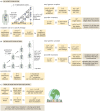This is a preprint.
The total number and mass of SARS-CoV-2 virions
- PMID: 33236021
- PMCID: PMC7685332
- DOI: 10.1101/2020.11.16.20232009
The total number and mass of SARS-CoV-2 virions
Update in
-
The total number and mass of SARS-CoV-2 virions.Proc Natl Acad Sci U S A. 2021 Jun 22;118(25):e2024815118. doi: 10.1073/pnas.2024815118. Proc Natl Acad Sci U S A. 2021. PMID: 34083352 Free PMC article.
Abstract
Quantitatively describing the time course of the SARS-CoV-2 infection within an infected individual is important for understanding the current global pandemic and possible ways to combat it. Here we integrate the best current knowledge about the typical viral load of SARS-CoV-2 in bodily fluids and host tissues to estimate the total number and mass of SARS-CoV-2 virions in an infected person. We estimate that each infected person carries 109-1011 virions during peak infection, with a total mass in the range of 1-100 μg, which curiously implies that all SARS-CoV-2 virions currently circulating within human hosts have a collective mass of only 0.1-10 kg. We combine our estimates with the available literature on host immune response and viral mutation rates to demonstrate how antibodies markedly outnumber the spike proteins and the genetic diversity of virions in an infected host covers all possible single nucleotide substitutions.
Figures



Similar articles
-
The total number and mass of SARS-CoV-2 virions.Proc Natl Acad Sci U S A. 2021 Jun 22;118(25):e2024815118. doi: 10.1073/pnas.2024815118. Proc Natl Acad Sci U S A. 2021. PMID: 34083352 Free PMC article.
-
Escape from neutralizing antibodies by SARS-CoV-2 spike protein variants.Elife. 2020 Oct 28;9:e61312. doi: 10.7554/eLife.61312. Elife. 2020. PMID: 33112236 Free PMC article.
-
Immunomolecular assay based on selective virion capture by spike antibody and viral nucleic acid amplification for detecting intact SARS-CoV-2 particles.J Nanobiotechnology. 2022 Sep 5;20(1):399. doi: 10.1186/s12951-022-01558-8. J Nanobiotechnology. 2022. PMID: 36064407 Free PMC article.
-
SARS-CoV-2 Evolutionary Adaptation toward Host Entry and Recognition of Receptor O-Acetyl Sialylation in Virus-Host Interaction.Int J Mol Sci. 2020 Jun 26;21(12):4549. doi: 10.3390/ijms21124549. Int J Mol Sci. 2020. PMID: 32604730 Free PMC article. Review.
-
Therapeutic potential of green tea catechin, (-)-epigallocatechin-3-O-gallate (EGCG) in SARS-CoV-2 infection: Major interactions with host/virus proteases.Phytomed Plus. 2023 Feb;3(1):100402. doi: 10.1016/j.phyplu.2022.100402. Epub 2022 Dec 30. Phytomed Plus. 2023. PMID: 36597465 Free PMC article. Review.
References
Publication types
Grants and funding
LinkOut - more resources
Full Text Sources
Other Literature Sources
Miscellaneous
